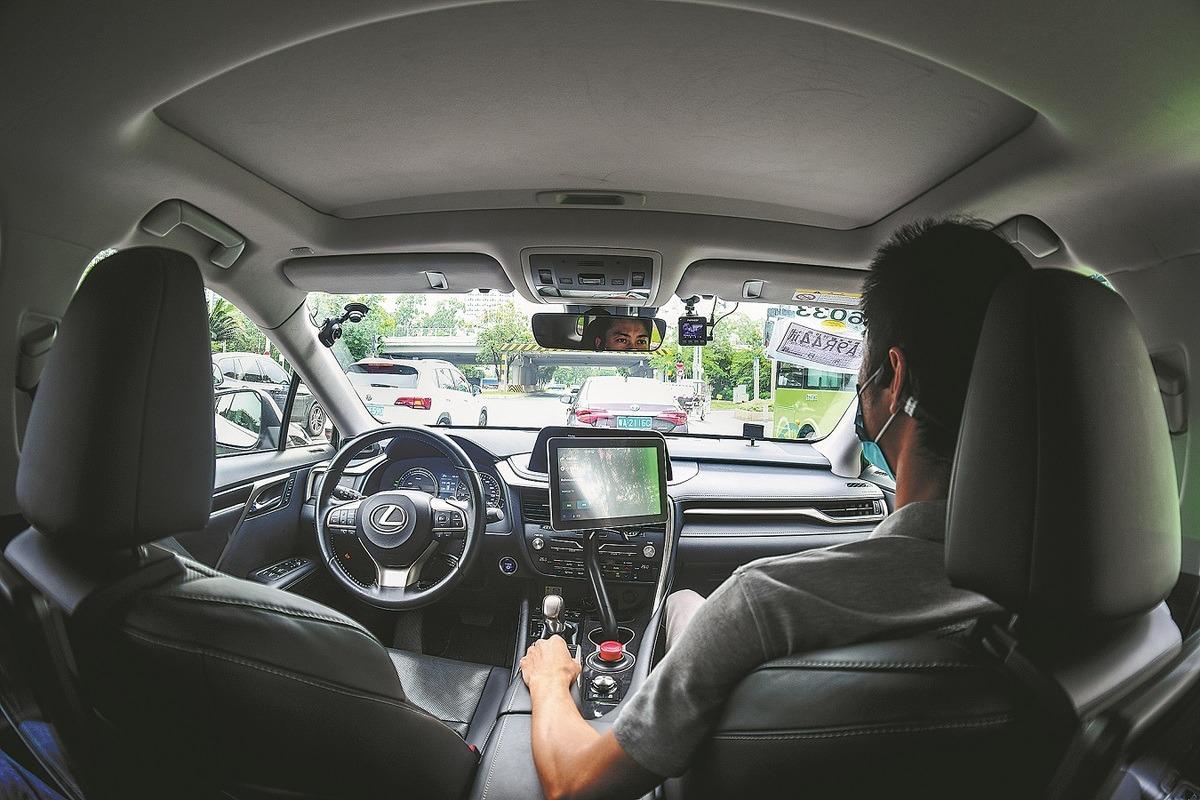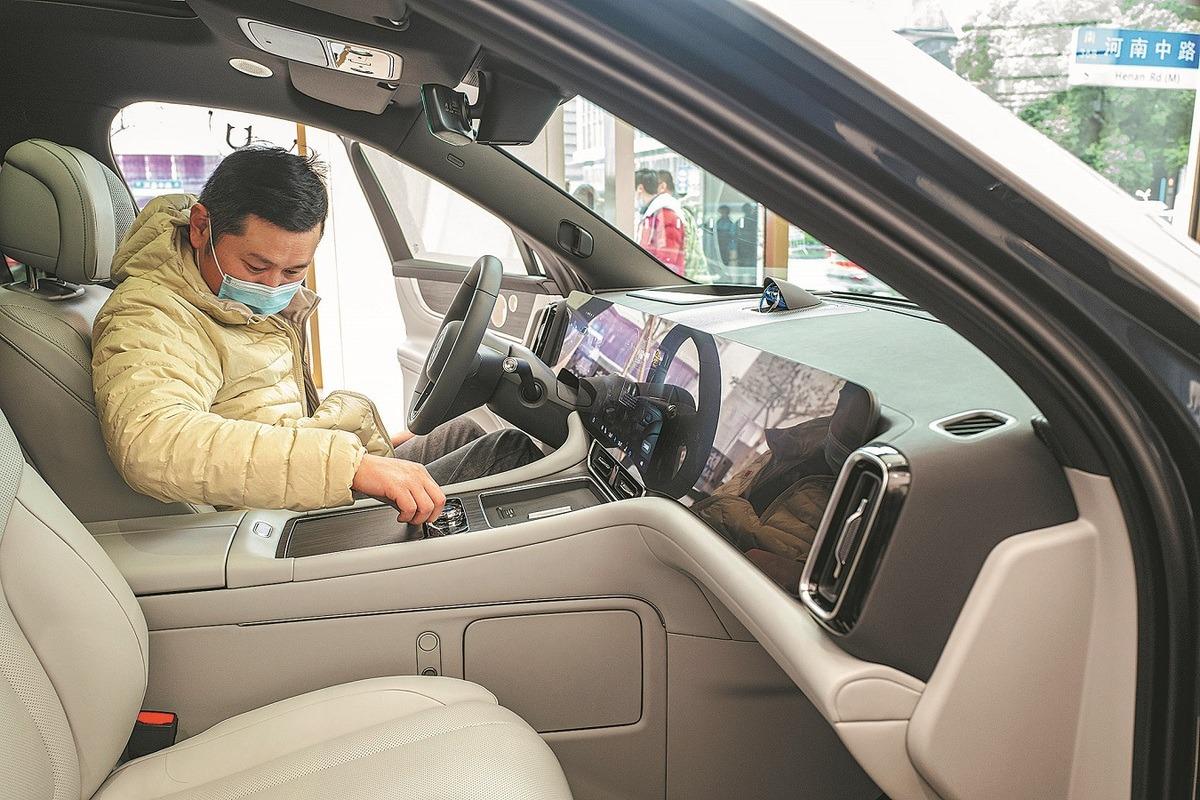As consumers look to upgrade to smarter electric autos, fully self-driving cars are getting closer
 Workers assemble GAC Aion new energy vehicles at a plant in Guangzhou, Guangdong province, in July. (PHOTO / XINHUA)
Workers assemble GAC Aion new energy vehicles at a plant in Guangzhou, Guangdong province, in July. (PHOTO / XINHUA)
Salesman Wu Keli is considering trading his gasoline car for a smart electric vehicle at the urging of his wife, Zhang Qing, who was recently given a ride by her friend in an Aito M7, a model codeveloped by the Chinese technology giant Huawei and carmaker Seres.
"My wife said our 2017 vehicle is nothing but a product of a previous era. She is impressed by all the flashy features in the M7, from voice command to automatic parking," said Wu, 35, who is from Beijing.
Despite initial resistance, Wu has taken to the "electric gadgets" after several test drives of models from car manufacturers such as Nio, Xpeng, Zeekr and Aito. "You can't resist the new-generation products. They can respond to your orders. In some scenarios, they can drive themselves. They are more than a car," he said.
In 2023, a total of 14.65 million new energy vehicles, including electric ones and plug-in hybrids, were sold globally, of which 9.5 million were bought in China, according to the China Association of Automobile Manufacturers
Wu and his wife are not alone. A survey of 2,499 potential car buyers in late 2023 by the consulting company McKinsey showed that 77 percent of the respondents were interested in buying a vehicle with automatic parking.
In the same survey, 76 percent said they would like a car that can drive autonomously on expressways, and 64 percent agreed that it is important for a vehicle to be able to navigate independently in urban traffic.
In 2023, a total of 14.65 million new energy vehicles, including electric ones and plug-in hybrids, were sold globally, of which 9.5 million were bought in China, according to the China Association of Automobile Manufacturers.
"It is possible to introduce some basic driving-assist functions into gasoline vehicles, but electric vehicles have their natural advantages in terms of precise control," Ouyang Minggao, an academician at the Chinese Academy of Sciences, said at an industry forum in March.
Nearly 40 percent of new energy vehicles sold in China in the first half of 2023 had advanced driving-assist features, and they were standard in most priced from 160,000 yuan ($22,231), China Passenger Car Association statistics show.
In contrast, only 18 percent of gasoline vehicles had such features, and the figure was 20 percent for those priced at 160,000 yuan.
The growth in advanced vehicle features has improved technology and cut costs, which in turn has spurred further development in the sector.
Industrial Securities auto analysts said in a report that the cost of hardware required for autonomous driving on expressways is 25,000 to 30,000 yuan. The priciest component is the lidar (light detecting and ranging) unit, which uses laser light to measure distances and map surroundings.
However, with the emphasis on visualization technologies, "the number of high-cost items may be cut, resulting in a drop in costs by up to 50 percent," the report said.
 A self-driving taxi operated by Pony.ai travels in Guangzhou, Guangdong. (PHOTO / XINHUA)
A self-driving taxi operated by Pony.ai travels in Guangzhou, Guangdong. (PHOTO / XINHUA)
Levels of autonomy
New energy vehicles will account for 70 percent of new vehicle sales in 2030 in China, with annual deliveries reaching around 20 million units a year, Ouyang said.
Smart functions, with autonomous driving features at the core, are proving to be more important as automakers try to distinguish their products from others on the market.
As these functions become more commonplace, more car buyers expect them to be offered as standard features, which will push automakers to make them a major focus of their technological development strategies.
He Xiaopeng, CEO of Xpeng, said his company will spend 3.5 billion yuan this year alone on research and development of smart functions.
"Today, the job entails a lot of computing power, a huge amount of data, a lot of money and a lot of people," he said.
Investment across the sector will see the technology make huge strides in the coming years, he said.
A high-level smart-driving system requires 0.1 human interventions per 100 kilometers on the expressway, but it requires over 10 per 100 km on urban roads, the CEO said.
"The system will do as good a job in urban traffic as on expressways in 18 to 36 months," he predicted.
Xpeng offers vehicle functions capable of urban navigation in over 240 cities in China. Relying on visualization — instead of high-precision mapping — it takes a few days for the company to make such functions available in a city.
However, to date, all such functions available in the market have been legally defined as Level 2, or "combined driver assistance" autonomous driving.
At this level, a vehicle can control steering, acceleration and deceleration, according to the Society of Automotive Engineers. But Level 2 falls short of self-driving, as a driver sits in the car and can take control of the vehicle at any time.
The society divides autonomous driving into six levels from 0 to 5, with Level 5 classified as true fully autonomous driving.
Some automakers argue that their vehicles have functions that are more advanced than Level 2, and want a "plus" category between levels 2 and 3.
From a technological perspective, the jump from Level 2 to Level 3 is substantial, according to Synopsys, an electronic design automation company based in California.
Level 3 vehicles have "environmental detection" capabilities and can make decisions for themselves, such as accelerating past a slow-moving vehicle or braking to prevent crashing into obstacles. However, they need driver intervention when necessary.
 A customer checks out an Aito M7 NEV at a Huawei flagship store in Shanghai on Dec 27. (PHOTO / CHINA DAILY)
A customer checks out an Aito M7 NEV at a Huawei flagship store in Shanghai on Dec 27. (PHOTO / CHINA DAILY)
Tipping point
Gu Huinan, president of Aion, the new energy vehicle arm of GAC Group, believes major change is just around the corner.
He estimates that Level 3 functions will be ready in terms of both hardware and software this year, and Level 4 vehicles, which do not need human intervention, will make a big impact in 2026.
A number of automakers are already testing Level 3 vehicles in China. In late 2023, Mercedes-Benz gained permission from Beijing municipal authorities to test such functions on designated highways in the capital.
Li Xiang, founder and CEO of Chinese NEV startup Li Auto, said the industry should not exaggerate the capabilities of such vehicles, and remove words like "autonomous" from advertisements
To adapt its Level 3 system to local infrastructure and traffic conditions, the German carmaker involved its Chinese research team from the beginning of the project. Since 2021, it has been working to adapt the system to local infrastructure and traffic conditions, such as the country's unique road signs, and markings, construction zones and special lanes, such as those for buses.
IM Motors, an electric vehicle company jointly established by Chinese carmaker SAIC Motor and e-commerce giant Alibaba, has also been given permission to test Level 3 vehicles on highways and expressways in Shanghai.
BMW, which is testing Level 3 vehicles in China, said it has started taking orders for such vehicles in the German market.
As more vehicles with varying levels of autonomy hit the roads, calls are also mounting for clearer legislation on their use. Issues already raised include the length of time a driver's hands can be off the steering wheel, and who should be held accountable for traffic accidents — the driver or the car manufacturer.
Drivers on expressways and major roads have said they have spotted autonomous vehicles with the drivers checking messages, making phone calls or even dozing off.
"There have been fatal accidents involving such vehicles. It is crucial to clearly tell their owners that the functions are to assist them, not replace them as drivers," said Zhang Yinuo, an office clerk in Beijing.
Li Xiang, founder and CEO of Chinese NEV startup Li Auto, said the industry should not exaggerate the capabilities of such vehicles, and remove words like "autonomous" from advertisements.
 GAC Aion new energy sports cars are assembled at a workshop in Guangzhou. (PHOTO / XINHUA)
GAC Aion new energy sports cars are assembled at a workshop in Guangzhou. (PHOTO / XINHUA)
Greenlight ahead
While automakers are gradually advancing from Level 2 functions, autonomous driving companies are placing a greater emphasis on driverless vehicles, classified as Level 4 or above, although some tailor Level 2 systems for car manufacturers as well. Despite their ambitions, they are less widely known among the public than the carmakers who sell such vehicles.
"Compared with driving-assist features found in private cars, autonomous driving will start from designated zones and gradually expand," said Thomas Fang, a partner at McKinsey's Shanghai office.
The Beijing municipal government has also unveiled plans to expand the scope of demonstration zones for high-level autonomous driving this year and promote self-driving services in areas such as airports and railway stations
One example is self-driving startup Pony.ai, which is backed by Toyota, the world's largest vehicle maker by sales.
Pony.ai runs fleets of driverless taxis in designated zones in four of China's tier-one cities: Beijing, Shanghai, Shenzhen and Guangzhou in Guangdong province. In Shenzhen, it offers 200 such rides a day.
Local government authorities are helping facilitate the technology's development. Pony.ai and Baidu were given permits in February to offer driverless-vehicle services at Beijing Daxing International Airport.
The two companies are also able to provide autonomous vehicles on the 40-km expressway connecting Beijing Daxing International Airport and the city's urban areas, as well as in some designated areas within the airport.
The Beijing municipal government has also unveiled plans to expand the scope of demonstration zones for high-level autonomous driving this year and promote self-driving services in areas such as airports and railway stations.
Chen Zhuo, general manager of Baidu's self-driving business unit, said the company is concentrating on expanding its commercial robotaxi fleet.
Like Pony.ai, Baidu's Level 4 autonomous vehicles are currently operating in designated zones in several cities, including Beijing, Chongqing, Wuhan, Hubei province and Shenzhen.
The company plans to expand its fleet size and operational area, and build the world's largest fully driverless ride-hailing zone, he added.
In the third quarter of 2023, its robotaxi fleet, Apollo Go, provided 821,000 rides, up 73 percent year-on-year. Didi offered 2.87 billion rides in the same period.
 Visitors experience a futuristic travel concept Neuron electric vehicle during an auto exhibition in Guangzhou in November. (PHOTO / XINHUA)
Visitors experience a futuristic travel concept Neuron electric vehicle during an auto exhibition in Guangzhou in November. (PHOTO / XINHUA)
Call me a cab
Despite a lack of clear business prospects so far, consulting firms are optimistic about the robotaxi sector in the long run.
China will be home to the largest fleet of robotaxis, according to BloombergNEF's Electric Vehicle Outlook, and there will be 12 million self-driving vehicles in the country by 2040, followed by the United States with around 7 million units.
Besides robotaxis, which are still in their infancy, Level 4 vehicles are already found at ports and mines, where safety requirements are less strict because there are a much smaller number of vehicles compared with urban roads.
Level 4 robotaxis are expected to become commercially available on a large scale by 2030, and fully autonomous trucking is expected to reach viability between 2028 and 2031, according to a McKinsey report
Eacon, a Chinese startup specializing in transportation at mines, expects its fleet to reach 1,000 Level 4 trucks. Established in 2018, it has inked deals with five major open mines in the country.
Long-haul heavy transportation is another sector that Level 4 vehicles are expected to have a major impact on, as drivers' salaries are one of the largest expenditures for logistics companies, said industry experts.
Earlier this year, Pony.ai obtained the country's first cross-provincial demonstration permit for its self-driving heavy-duty trucks. The permit allows the company to conduct vehicle tests at speeds of up to 90 km on the Beijing and Tianjin sections of the Beijing-Tianjin-Tanggu expressway.
Before obtaining the permit, Pony.ai had tested vehicles in several other cities, with its accumulated tests reaching almost 4 million km.
However, there is still a long way to go, for both robotaxis and highly autonomous trucks, to become part of everyday life on China's roads.
Level 4 robotaxis are expected to become commercially available on a large scale by 2030, and fully autonomous trucking is expected to reach viability between 2028 and 2031, according to a McKinsey report.


